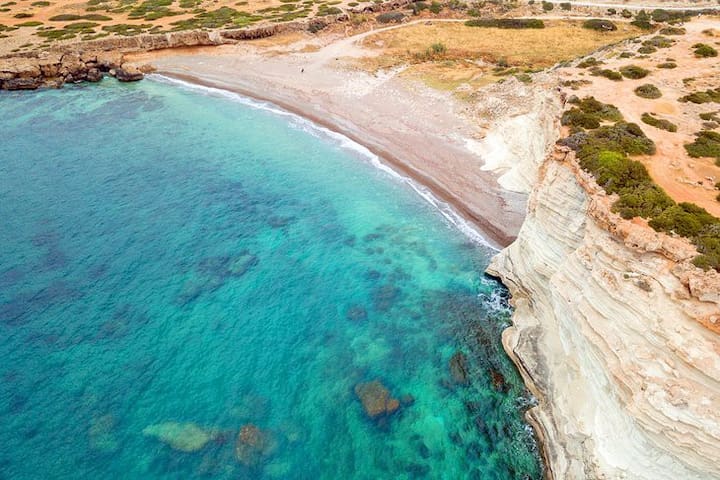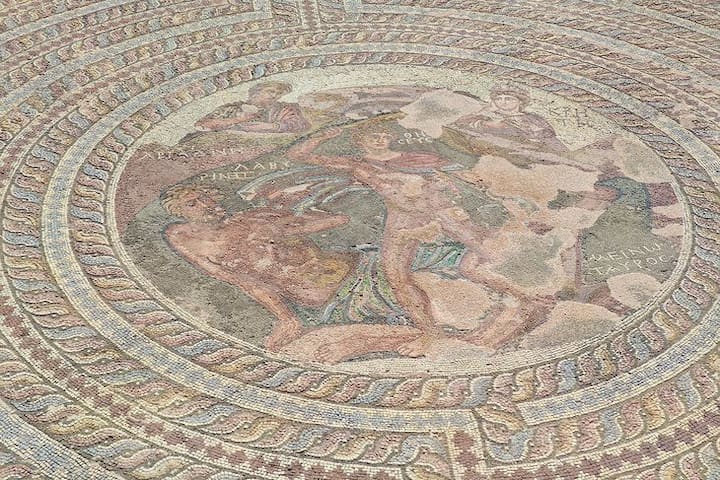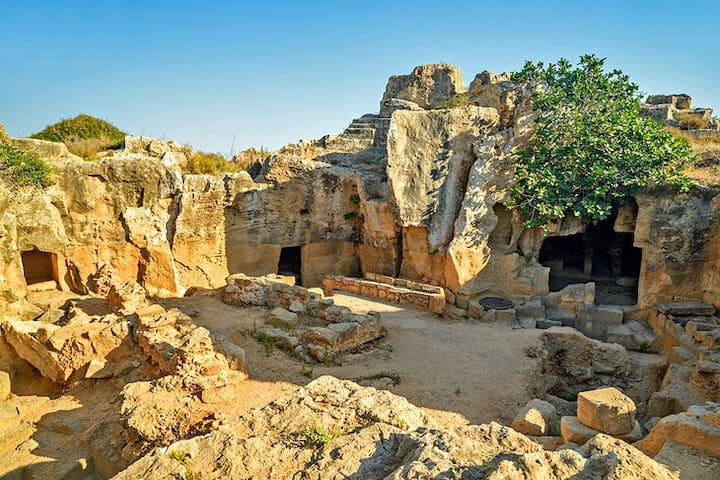Sightseeing
Despite the wealth of historical sites in and around Paphos, the resort's main tourist attractions remains its superb beaches.
On the east side of town is lovely Alykes Beach with plenty of good facilities, making it a top choice for holidaymakers with children in tow.
Another very popular choice is Coral Bay, eight kilometers north of central Paphos. Its curving strip of soft, golden sand with plenty of sun loungers for rent, water sports operators offering paddleboard and kayak rental, and a couple of restaurants for lunch make it a favorite for easygoing days of sun, sand, and swimming.
All the full-facility beaches in the area have lifeguards on patrol throughout the summer months, and most have designated swimming areas.
For somewhere a bit less crowded, head to Kissonerga Bay (eight kilometers north of town), which has a gorgeously inviting strip of sand but rarely sees more than a handful of visitors thanks to its few facilities.
For a wild beach, Lara Beach (26 kilometers north), on the Akamas Heights, is the number one beach spot in the area, and is rated as one of the best on the entire island. Here, you'll find a cove of supreme sandy bliss that is also an important turtle nesting site during summer.
88 yerel halk öneriyor
Lara Beach
Despite the wealth of historical sites in and around Paphos, the resort's main tourist attractions remains its superb beaches.
On the east side of town is lovely Alykes Beach with plenty of good facilities, making it a top choice for holidaymakers with children in tow.
Another very popular choice is Coral Bay, eight kilometers north of central Paphos. Its curving strip of soft, golden sand with plenty of sun loungers for rent, water sports operators offering paddleboard and kayak rental, and a couple of restaurants for lunch make it a favorite for easygoing days of sun, sand, and swimming.
All the full-facility beaches in the area have lifeguards on patrol throughout the summer months, and most have designated swimming areas.
For somewhere a bit less crowded, head to Kissonerga Bay (eight kilometers north of town), which has a gorgeously inviting strip of sand but rarely sees more than a handful of visitors thanks to its few facilities.
For a wild beach, Lara Beach (26 kilometers north), on the Akamas Heights, is the number one beach spot in the area, and is rated as one of the best on the entire island. Here, you'll find a cove of supreme sandy bliss that is also an important turtle nesting site during summer.
he mosaic pavements of the House of Dionysus, and the surrounding mosaic houses, are among the finest to be found in the Mediterranean and are among the top tourist attractions in Cyprus. They are part of the larger Paphos Archaeological Site, which spans the western side of the harbor and is a UNESCO World Heritage Site.
Discovered accidentally by a farmer ploughing his fields, the mosaic artwork here is excellently preserved, depicting scenes from Greek mythology using vibrant natural limestone colors.
One of the most well-known mosaics is found at the back of the house, depicting a Ganymede being taken back to Olympus by an eagle. The most famous mosaic, though, is the scene depicting the triumph of Dionysos with the God in a chariot drawn by leopards, while behind him are a gathering of followers engaged in various revelries.
Just opposite the House of Dionysos is the House of Aion, where five mosaic scenes of superb quality still survive.
In this house, look to the top left for a depiction of Leda and Zeus in the form of a swan. The top right panel shows Dionysos as a baby, accompanied by various nymphs, and the middle panel depicts a beauty contest between sea nymphs of which Aion is the judge. The final picture shows Apollo punishing a foolish man who had challenged the God to a musical duel and lost.
The House of Theseus is nearby and is worth a visit for the south wing mosaic depicting Theseus at battle with a Minotaur.
Address: Kyriakou Nikolaou Street, Paphos Archaeological Site, Kato Paphos
13 yerel halk öneriyor
The House of Dionysus
he mosaic pavements of the House of Dionysus, and the surrounding mosaic houses, are among the finest to be found in the Mediterranean and are among the top tourist attractions in Cyprus. They are part of the larger Paphos Archaeological Site, which spans the western side of the harbor and is a UNESCO World Heritage Site.
Discovered accidentally by a farmer ploughing his fields, the mosaic artwork here is excellently preserved, depicting scenes from Greek mythology using vibrant natural limestone colors.
One of the most well-known mosaics is found at the back of the house, depicting a Ganymede being taken back to Olympus by an eagle. The most famous mosaic, though, is the scene depicting the triumph of Dionysos with the God in a chariot drawn by leopards, while behind him are a gathering of followers engaged in various revelries.
Just opposite the House of Dionysos is the House of Aion, where five mosaic scenes of superb quality still survive.
In this house, look to the top left for a depiction of Leda and Zeus in the form of a swan. The top right panel shows Dionysos as a baby, accompanied by various nymphs, and the middle panel depicts a beauty contest between sea nymphs of which Aion is the judge. The final picture shows Apollo punishing a foolish man who had challenged the God to a musical duel and lost.
The House of Theseus is nearby and is worth a visit for the south wing mosaic depicting Theseus at battle with a Minotaur.
Address: Kyriakou Nikolaou Street, Paphos Archaeological Site, Kato Paphos
A short two-kilometer stroll out of town brings you to the rock-cut chambers of the Tombs of the Kings. These impressive underground tombs date to the 4th century BCE and are carved out of solid rock, some decorated with Doric pillars and all sporting a distinct Egyptian influence.
This UNESCO World Heritage Site was a burial ground for ancient Paphos during the Greek and Roman periods and probably was used for high ranking officials or members of society of those eras.
There are seven tombs to explore here, but if you're short on time, make a beeline for tomb number three which contains the most interesting architectural elements with a wealth of columns surrounding its atrium.
Address: Tombs of the Kings Street
8 yerel halk öneriyor
Tombs of the Kings Avenue
Tombs of the Kings AvenueA short two-kilometer stroll out of town brings you to the rock-cut chambers of the Tombs of the Kings. These impressive underground tombs date to the 4th century BCE and are carved out of solid rock, some decorated with Doric pillars and all sporting a distinct Egyptian influence.
This UNESCO World Heritage Site was a burial ground for ancient Paphos during the Greek and Roman periods and probably was used for high ranking officials or members of society of those eras.
There are seven tombs to explore here, but if you're short on time, make a beeline for tomb number three which contains the most interesting architectural elements with a wealth of columns surrounding its atrium.
Address: Tombs of the Kings Street
View the Chrysopolitissa Basilica & St. Paul's Pillar
This extensive ruin was once Byzantine Paphos' largest basilica, and the scattered columns and remnants of once beautiful mosaics are testament to its long-gone grandeur.
It probably dates from the 4th century – at the height of Byzantine power in Cyprus – and was destroyed in CE 653 during the Arab raids across the island.
At the eastern end of the site is the Ayia Kyriaki Church, which is still in use today for Catholic and Anglican services.
At the western end of the site is St. Paul's Pillar, locally believed to be the pillar where St. Paul was bound and given 39 lashes as a punishment for preaching Christianity. After this he managed to convert the governor to Christianity making Cyprus one of the first Christian states in the world.
13 yerel halk öneriyor
Panagia Chrysopolitissa Kilisesi
Panagias TheoskepastisView the Chrysopolitissa Basilica & St. Paul's Pillar
This extensive ruin was once Byzantine Paphos' largest basilica, and the scattered columns and remnants of once beautiful mosaics are testament to its long-gone grandeur.
It probably dates from the 4th century – at the height of Byzantine power in Cyprus – and was destroyed in CE 653 during the Arab raids across the island.
At the eastern end of the site is the Ayia Kyriaki Church, which is still in use today for Catholic and Anglican services.
At the western end of the site is St. Paul's Pillar, locally believed to be the pillar where St. Paul was bound and given 39 lashes as a punishment for preaching Christianity. After this he managed to convert the governor to Christianity making Cyprus one of the first Christian states in the world.
here are dozens of cruise trips to choose from in Paphos. Most offer a four- or six-hour itinerary that includes lunch.
The normal route casts off from Paphos harbor and then cruises north up the island's west coast from town with a stop for swimming and snorkeling at Coral Bay before returning back to Paphos.
This allows you views of the coast all along the way, with great opportunities to photograph Paphos Fort from the sea.
There is also a turtle-watching cruise boat that offers a two-hour trip on a specially adapted boat with windows below deck for easy spotting of turtles. The tour also includes a swimming and snorkeling stop.
There are also boat trips offered from the harbor at Latsi (the nearest town to the Akamas Peninsula). Most of these head to the sparkling turquoise bay of the Blue Lagoon, near the tip of the Akamas Peninsula, for swimming and snorkeling
94 yerel halk öneriyor
Blue Lagoon
here are dozens of cruise trips to choose from in Paphos. Most offer a four- or six-hour itinerary that includes lunch.
The normal route casts off from Paphos harbor and then cruises north up the island's west coast from town with a stop for swimming and snorkeling at Coral Bay before returning back to Paphos.
This allows you views of the coast all along the way, with great opportunities to photograph Paphos Fort from the sea.
There is also a turtle-watching cruise boat that offers a two-hour trip on a specially adapted boat with windows below deck for easy spotting of turtles. The tour also includes a swimming and snorkeling stop.
There are also boat trips offered from the harbor at Latsi (the nearest town to the Akamas Peninsula). Most of these head to the sparkling turquoise bay of the Blue Lagoon, near the tip of the Akamas Peninsula, for swimming and snorkeling
Although it's tiny, the Paphos Fort is one of the most recognizable sights in Paphos. Built in 1592 by the Ottomans, it is sited over an earlier medieval castle built by the Lusignans, which in turn was built over an earlier Byzantine fort.
You enter by crossing a tiny bridge across a moat. Its prime position, overlooking the harbor, made it an excellent line of defense for the town. This is the number one spot in town for sweeping views across the Mediterranean. Climb to the roof for great panoramas of the harbor area and the sea beyond.
There are also ruins of another fort on the breakwater, but these consist only of two lumps of rock.
Address: Paphos Harbor, Kato Paphos
84 yerel halk öneriyor
Paphos Castle
Although it's tiny, the Paphos Fort is one of the most recognizable sights in Paphos. Built in 1592 by the Ottomans, it is sited over an earlier medieval castle built by the Lusignans, which in turn was built over an earlier Byzantine fort.
You enter by crossing a tiny bridge across a moat. Its prime position, overlooking the harbor, made it an excellent line of defense for the town. This is the number one spot in town for sweeping views across the Mediterranean. Climb to the roof for great panoramas of the harbor area and the sea beyond.
There are also ruins of another fort on the breakwater, but these consist only of two lumps of rock.
Address: Paphos Harbor, Kato Paphos
The Sanctuary of Aphrodite is inside the Palaipaphos Archaeological Site in the village of Kouklia, a 16-kilometer drive southeast from central Paphos.
The goddess was not represented in human form but by the conical stone, which was anointed with oil. Around the court are several chambers, which are a mixture of early construction and later Roman additions.
The south wing is the best preserved of the building. There was possibly a Phoenician temple inside this wing in a small courtyard, but Roman reconstruction has added to the confusion of the original layout.
West of the sanctuary are Roman remains including a large Roman peristyle house built in CE 1. It consists of rooms around a colonnaded atrium and contains mosaics. The house was possibly a residence for the priests who tended the sanctuary.
There are ruins of several other Roman houses on the site, most notably the house of Leda. This is reached on a marked path, and contains a copy of the mosaic depicting Leda and the Swan (the most famous in Cyprus).
12 yerel halk öneriyor
Sanctuary of Aphrodite
1 Γρίβα ΔιγενήThe Sanctuary of Aphrodite is inside the Palaipaphos Archaeological Site in the village of Kouklia, a 16-kilometer drive southeast from central Paphos.
The goddess was not represented in human form but by the conical stone, which was anointed with oil. Around the court are several chambers, which are a mixture of early construction and later Roman additions.
The south wing is the best preserved of the building. There was possibly a Phoenician temple inside this wing in a small courtyard, but Roman reconstruction has added to the confusion of the original layout.
West of the sanctuary are Roman remains including a large Roman peristyle house built in CE 1. It consists of rooms around a colonnaded atrium and contains mosaics. The house was possibly a residence for the priests who tended the sanctuary.
There are ruins of several other Roman houses on the site, most notably the house of Leda. This is reached on a marked path, and contains a copy of the mosaic depicting Leda and the Swan (the most famous in Cyprus).



